Welcome to our article on the Majestic Echinodorus Bleheri, the Amazon Sword Plant.
This freshwater aquarium plant is truly a magnificent addition to any aquatic space.
With its lush green leaves and impressive size, Echinodorus Bleheri brings a touch of elegance and grandeur to your underwater world.
In this article, we will explore Echinodorus Bleheri’s natural habitat, its role in aquascaping, care tips, and the wider Echinodorus family.
Get ready to dive into the world of Echinodorus Bleheri and discover its unique beauty.
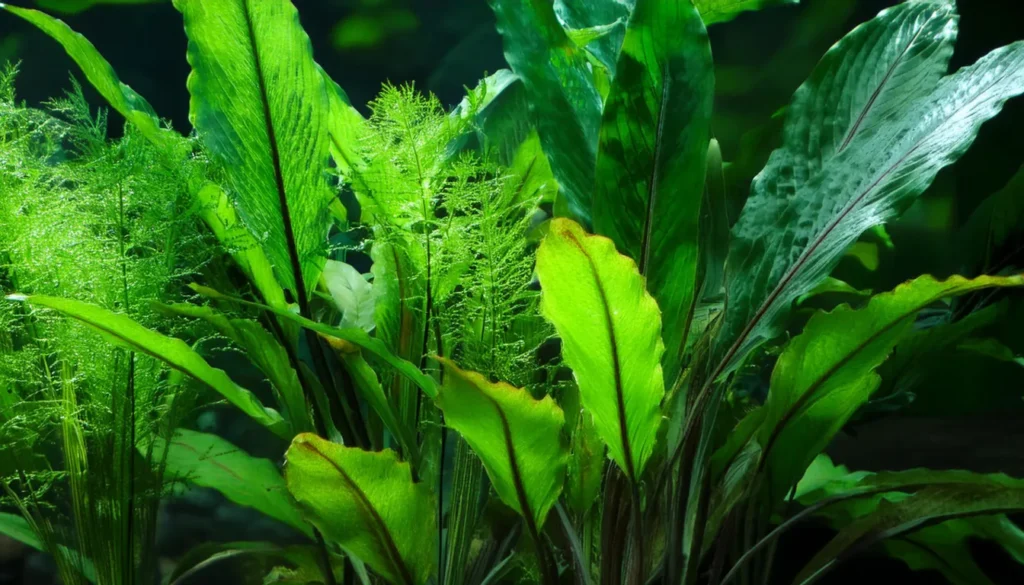
Key Takeaway
- Echinodorus Bleheri, also known as the Amazon Sword Plant, is a magnificent freshwater aquarium plant.
- Its lush green leaves and impressive size add elegance and grandeur to any aquatic space.
- In this article, we will explore the natural habitat of Echinodorus Bleheri, its role in aquascaping, care tips, and the wider Echinodorus family.
- Discover the beauty and versatility of Echinodorus Bleheri in transforming your freshwater aquarium into a thriving oasis.
- Join us as we delve into the world of Echinodorus Bleheri and unlock its secrets.
Quick Stats
| Attribute | Details |
| Family Name | Alismataceae |
| Origin | South America |
| Height | 20-50 cm (8-20 inches), can reach larger sizes depending on tank conditions |
| pH Range | 6.5 – 7.5 |
| CO2 Requirement | Low |
| Growth Rate | Moderate |
| Care Level | Easy |
| Color Form | Bright to Dark Green |
| Water Conditions | 22-28°C (72-82°F), adaptable to a wide range of hardness |
| Max Size | Can produce leaves over 50 cm (20 inches) in length in ideal conditions |
| Lighting | Moderate |
| Supplements | Benefits from root tabs and liquid fertilizers |
| Placement | Background |
| Propagation | By adventitious shoots from the base |
What Is Echinodorus Bleheri?
Echinodorus Bleheri is an aquatic plant in the Alismataceae family. Native to South America, it is commonly found in the Amazon basin and other parts of Brazil.
This plant is highly sought after by aquarium enthusiasts due to its attractive appearance and ease of care.
Its long, sword-shaped leaves and vibrant green color make it popular for planted tanks.
Let’s take a closer look at Echinodorus Bleheri’s natural habitat and understand its preferences.
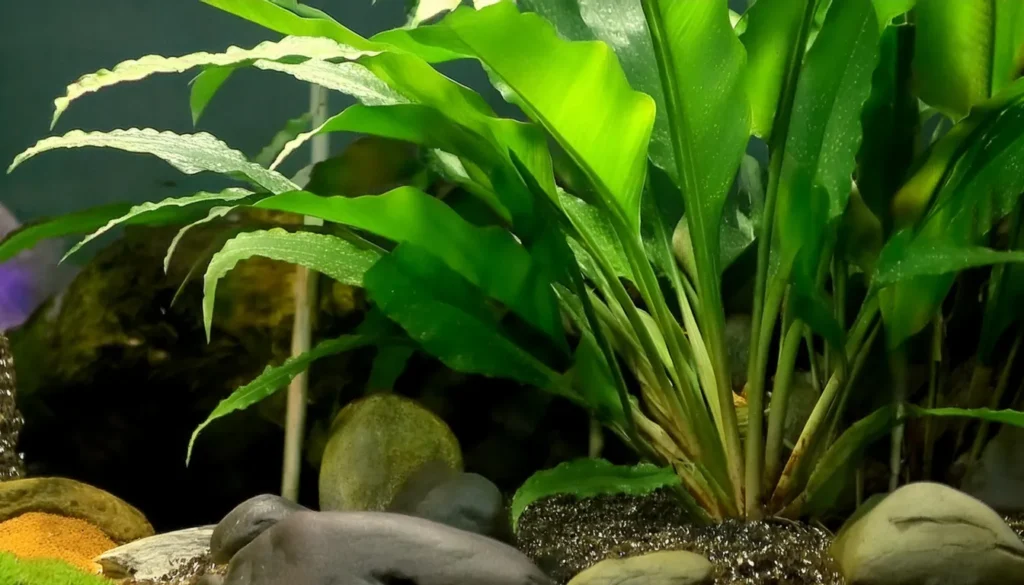
Natural Habitat And Origin
- Echinodorus bleheri, commonly known as Amazon sword plant, is a popular aquatic plant in the aquarium hobby, prized for its lush, green foliage and ease of care. Originating from the Amazon Basin, it is found in a wide range of freshwater habitats in South America, including Brazil, Colombia, and Peru.
- Its natural habitat encompasses slow-moving or stationary waters, such as shallow streams, small rivers, and the edges of lakes and ponds, where it can receive ample sunlight. These environments are typically warm, with a temperature range that the plant thrives in, and have soft, acidic to neutral pH levels. The substrate in these areas is often rich in organic matter, providing the necessary nutrients for the plant’s growth.
- In the wild, Echinodorus bleheri can grow both submerged and partially submerged during the rainy season when water levels rise. This adaptability allows it to survive in varying conditions, making it a versatile plant for aquariums. Its ability to grow large and create a dense foliage makes it an excellent background plant in aquarium setups, providing shelter and breeding grounds for fish and other aquatic animals.
Physical Characteristics
- Echinodorus Bleheri is recognizable for its long, sword-shaped leaves, which can grow up to 20 inches (50 cm) in height. The leaves typically exhibit a vibrant green color, although variations with red or bronze tones can also be found.
- Additionally, this plant boasts a robust root system, firmly anchoring it in the substrate of your aquarium.
Lighting Needs Of The Plant
The Echinodorus bleheri, commonly known as the Amazon sword plant, has moderate lighting needs, making it a suitable choice for a wide range of aquarium setups.
In its natural habitat, this plant is accustomed to receiving sunlight filtered through water and, in some cases, shaded by larger trees or vegetation along the banks of rivers and streams.
This adaptation allows it to thrive in both brightly lit environments and in conditions where lighting is less intense.
For aquarium cultivation, the Amazon sword plant does best under medium lighting conditions.
Specifically, it is recommended to provide lighting in the range of 0.5 to 0.7 watts per liter (or 2 to 3 watts per gallon) when using fluorescent or LED lighting.
This level of lighting will support healthy growth, allowing the plant to develop its characteristic lush, green leaves.
However, Echinodorus bleheri is quite adaptable and can also grow in lower light conditions, albeit at a slower rate.
In such environments, its leaves may become longer and thinner as the plant stretches towards the light source.
Conversely, under high light conditions, the plant will grow more compactly and may produce more vibrant or deeper green foliage.
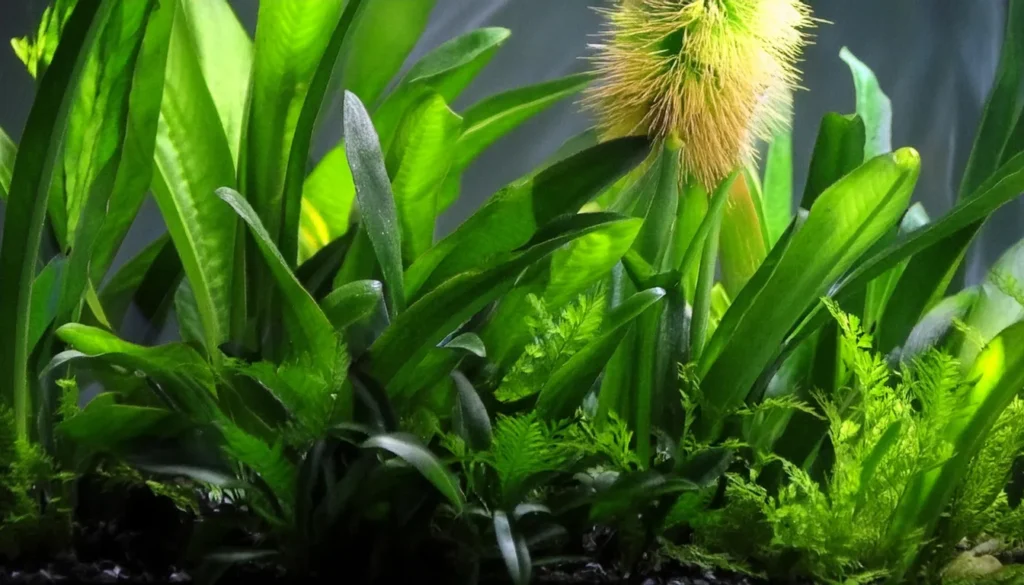
Temperature Parameters
- Echinodorus bleheri, known for its adaptability and ease of care, thrives in a wide range of water temperatures, making it an excellent choice for tropical aquariums. The ideal temperature range for this plant is between 22°C to 28°C (72°F to 82°F). This range mimics the warm waters of its native Amazon Basin environment, promoting healthy growth and vibrant foliage.
- At temperatures within this optimal range, the Amazon sword plant can efficiently photosynthesize, absorb nutrients, and maintain a strong root system. It’s worth noting that while Echinodorus bleheri can tolerate a slight deviation outside this range, prolonged exposure to temperatures much lower or higher can stress the plant, potentially leading to poor growth, susceptibility to diseases, or even death.
- Lower temperatures can slow down the plant’s metabolism, resulting in stunted growth and less vigorous foliage. On the other hand, excessively high temperatures can lead to increased respiration rates, which might not only stress the plant but also affect the dissolved oxygen levels in the water, potentially impacting fish and other aquatic life.
RELATED: Vibrant Echinodorus Aflame Aquarium Plant Guide For Beginners
Water Conditions
- Echinodorus Bleheri prefers freshwater environments with stable water parameters. It thrives in temperatures ranging from 72°F to 82°F (22°C to 28°C) and a pH level between 6.5 and 7.5.
- The plant requires moderate to high lighting to support photosynthesis and maintain its vibrant coloration.
Substrate Requirement
- Nutrient-Rich: A substrate that is specifically designed for aquatic plants, rich in essential nutrients like iron.
- Fine to Medium Grain Size: Allows for easy root penetration and strong anchorage without compacting too tightly around the roots.
- Depth of 3-4 Inches: Sufficient depth to support the plant’s extensive root system and accommodate its potential for tall growth.
- Specifically Designed for Aquatic Plants: Commercially available substrates formulated for the needs of aquatic plants are ideal, providing a balance of nutrient content and physical structure.
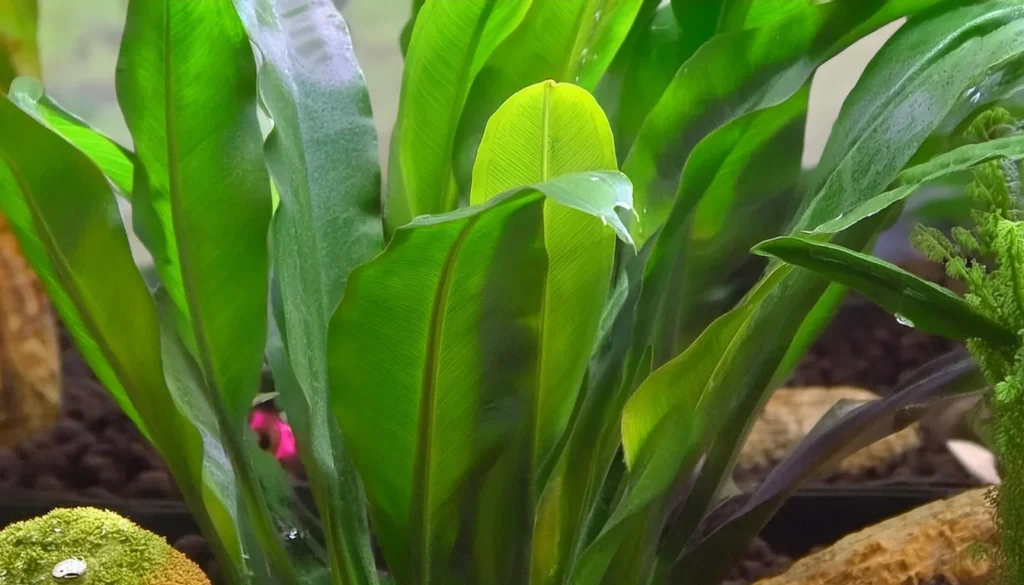
Placement Options In The Tank
Background Placement
- Ideal for Larger Tanks: Given its potential to grow tall and wide, placing it in the background helps create a lush, green backdrop that enhances the depth and beauty of the aquarium.
- Space for Growth: Allows ample space for the plant to reach its full size without obscuring other plants or decorations.
Centerpiece Placement
- Focal Point: In medium-sized tanks, Echinodorus bleheri can serve as an impressive centerpiece, especially when planted solitarily or in a small group. Its vibrant foliage and substantial size draw the eye, making it a natural focal point.
- Room for Expansion: Ensures there’s enough space around it for expansion, preventing it from crowding out nearby plants.
Side Placement
- Accentuating Tank Edges: When placed on the sides, it can help soften the edges of the tank and create a more natural-looking transition between the foreground and background plants.
- Strategic Screening: Can be used to hide equipment or tank features like heaters, filters, and cords, integrating functionality with aesthetic appeal.
Considerations For Placement
- Light and Flow: Ensure the plant has access to adequate light and is not in the direct path of strong water flow, which can damage its leaves.
- Root System Space: Whichever placement you choose, ensure there’s enough substrate depth to accommodate its root system, promoting healthy growth.
- Visibility: Place it where its growth won’t obstruct the view of smaller plants or detract from the tank’s overall design.
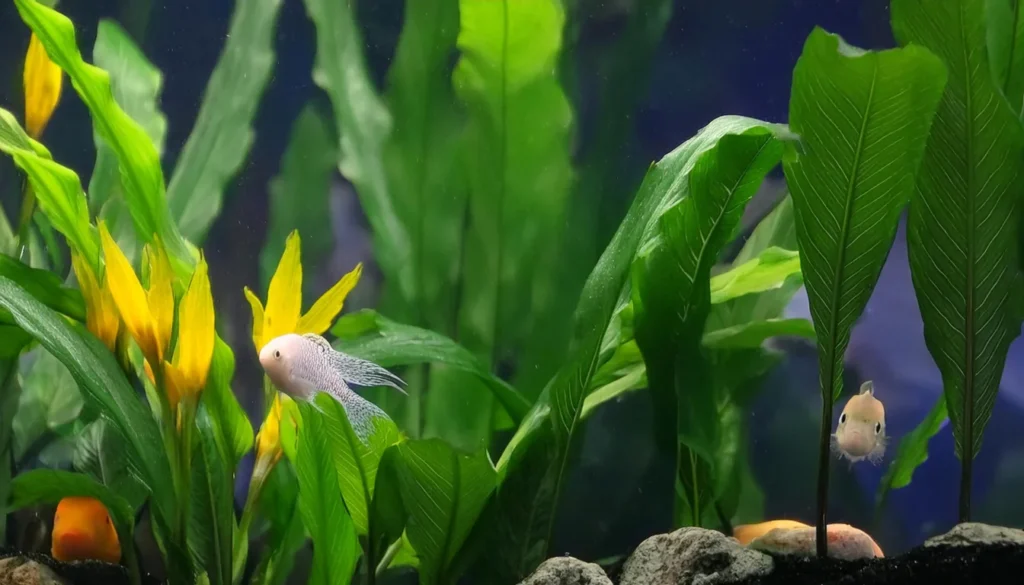
Recommended Tank Size
- The recommended tank size for Echinodorus bleheri, commonly known as Amazon Sword plant, depends on various factors including the size of the plant, the number of plants, and the overall setup of the aquarium.
- Echinodorus bleheri is a large and robust aquarium plant that can grow quite tall and wide under optimal conditions. It is often used as a background or centerpiece plant in larger aquariums.
- For a single Echinodorus bleheri plant, a tank size of at least 20 gallons (about 75 liters) would be suitable. This allows enough space for the plant to grow and spread its leaves without overcrowding the tank. However, if you plan to keep multiple Amazon Sword plants or want to create a dense, lush background with them, you would need a larger tank, such as a 40-gallon (about 150 liters) or even larger aquarium.
Suitable Tank Mates
- Small to Medium-sized Community Fish: Many peaceful community fish make good tank mates for Amazon Sword plants. Examples include tetras (such as neon tetras, cardinal tetras), rasboras, guppies, mollies, platies, and dwarf gouramis.
- Bottom Dwellers: Species that inhabit the lower levels of the aquarium can coexist well with Amazon Sword plants. Consider adding Corydoras catfish, dwarf corydoras, or small species of loaches like kuhli loaches.
- Algae Eaters: Fish that help control algae can be beneficial in an aquarium with Amazon Sword plants. Siamese algae eaters, otocinclus catfish, and certain species of plecos (like bristlenose plecos) can help keep algae in check.
- Shrimp and Snails: Many species of freshwater shrimp, such as cherry shrimp or Amano shrimp, as well as nerite snails and Malaysian trumpet snails, can peacefully coexist with Amazon Sword plants and help clean up debris.
RELATED: A Comprehensive Guide To Planting Cryptocoryne Wendtii Tropica
Nutritional Needs Of The Plant
Echinodorus bleheri, like all plants, requires a variety of nutrients to thrive. These nutrients can be broadly categorized into two groups: macro and micronutrients.
Macro Nutrients
- Nitrogen (N): Nitrogen is a primary component of chlorophyll, the green pigment responsible for photosynthesis. It’s essential for the growth of stems and leaves. In aquariums, nitrogen is typically provided through fish waste, decaying organic matter, and fertilizers containing nitrogen compounds such as nitrates (NO3-) and ammonium (NH4+).
- Phosphorus (P): Phosphorus is crucial for energy transfer within cells and is involved in processes like photosynthesis, respiration, and cell division. It promotes healthy root development and flowering. Phosphorus is often present in aquarium substrates and can be supplemented through specialized fertilizers containing phosphates (PO4^3-).
- Potassium (K): Potassium plays a vital role in enzyme activation, osmoregulation, and the synthesis of proteins and carbohydrates. It contributes to overall plant health, enhances disease resistance, and regulates water balance within plant cells. Potassium is commonly provided through potassium sulfate or potassium nitrate fertilizers.
- Calcium (Ca) and Magnesium (Mg): Calcium and magnesium are essential for the formation of cell walls, chlorophyll synthesis, and enzyme activation. They help maintain proper plant structure, enhance nutrient uptake, and prevent deficiencies like yellowing leaves. These nutrients can be supplemented through aquarium water changes or specialized fertilizers.
Micronutrients
- Iron (Fe): Iron is crucial for chlorophyll synthesis and is involved in electron transport during photosynthesis. It’s necessary for the production of enzymes and proteins essential for plant growth and metabolism. Iron deficiency can lead to yellowing leaves and poor growth. Iron can be supplemented through chelated iron fertilizers.
- Manganese (Mn), Zinc (Zn), Copper (Cu), Boron (B), Molybdenum (Mo), and Chlorine (Cl): These micronutrients play specific roles in enzyme activation, photosynthesis, hormone regulation, and nutrient transport within plants. Deficiencies in any of these micronutrients can manifest as various growth abnormalities and decreased plant vigor. Micronutrient supplements containing these elements can help prevent deficiencies.
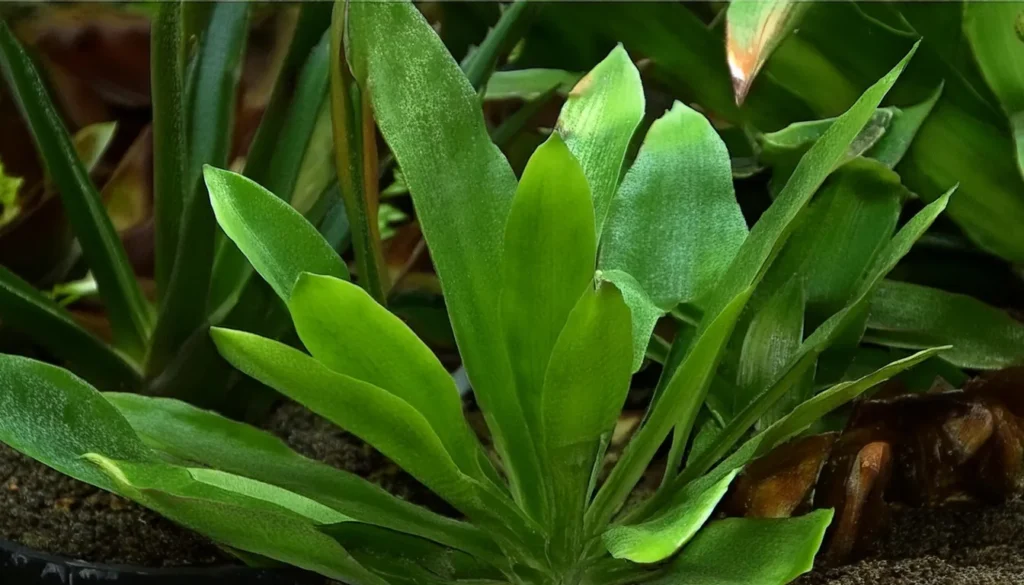
Plant Maintenance Tips
- Regularly trim the plant to control its size and shape. Remove any yellow or damaged leaves to maintain a neat appearance.
- Monitor the water parameters, such as temperature, pH, and hardness, to ensure they remain within the suitable range for Echinodorus Bleheri.
- Perform regular water changes to maintain water quality and remove any accumulated debris or excess nutrients that might promote algae growth.
- Monitor and address any signs of pest infestation or disease promptly.
Cultivating Amazon Sword Plant At Home
- Choose Healthy Specimens: When selecting Amazon Sword plants for your aquarium, choose specimens with vibrant green leaves and firm roots. Avoid plants with yellowing or damaged leaves, as they may struggle to adapt to your tank environment.
- Proper Planting Technique: Plant Amazon Sword plants in the substrate gently but firmly. Ensure that the roots are fully covered with substrate to prevent them from floating or becoming exposed.
- Provide Adequate Lighting: Amazon Sword plants thrive in moderate to high lighting conditions. Invest in a quality aquarium light with appropriate intensity and spectrum to promote healthy growth. Aim for around 8-10 hours of light per day, adjusting as needed based on plant response.
- Nutrient-Rich Substrate: Use a nutrient-rich substrate or add root tabs to provide essential nutrients to the plant’s roots. This helps promote strong root development and overall growth.
- Fertilization: Consider supplementing your aquarium with liquid or tablet fertilizers specifically formulated for aquarium plants. Look for products containing essential macro and micronutrients like nitrogen, phosphorus, potassium, iron, and trace elements.
Propagation Tips
- Identify Runners: Amazon Sword plants produce long, slender stems called runners that extend horizontally across the substrate. These runners will eventually develop small plantlets with roots and leaves.
- Encourage Runner Formation: Provide optimal growing conditions, including adequate lighting, nutrient-rich substrate, and proper water parameters, to encourage the formation of runners. Healthy and well-maintained plants are more likely to produce runners.
- Monitor Growth: Regularly inspect your Amazon Sword plants for the development of new runners. Runners typically emerge from the base of the parent plant and extend outward across the substrate.
- Rooting Plantlets: Once a runner has produced plantlets with roots and leaves, allow them to grow until the roots are well-established. This usually takes several weeks. You can gently press the plantlets into the substrate to encourage rooting, or they may root on their own.
- Separate Plantlets: Once the plantlets have developed a sufficient root system and several leaves, they can be carefully separated from the parent plant. Use sharp scissors or a razor blade to cut the runner between the parent plant and the plantlet.
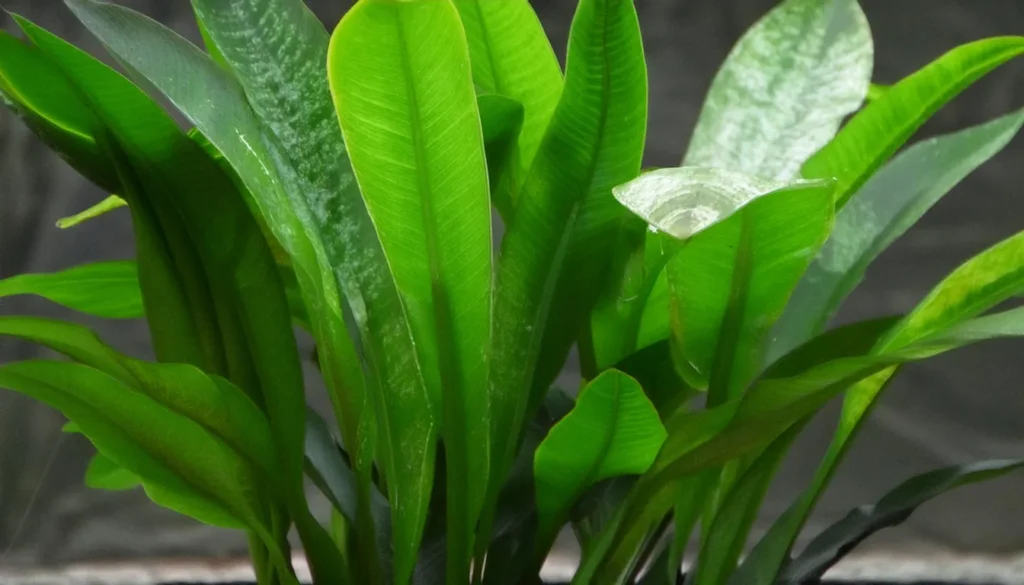
Benefits Of Planting Amazon Sword Plant
- Echinodorus Bleheri, also known as the Amazon Sword Plant, is crucial in companion planting in a diverse aquarium.
- Its tall and sturdy structure provides shade and shelter for smaller, more delicate plants, creating a visually appealing and well-balanced underwater landscape.
- By serving as a companion plant, Echinodorus bleheri enhances the overall aesthetic of the aquarium while also benefiting other plants in the ecosystem.
- One of the notable advantages of companion planting with Echinodorus Bleheri is its ability to absorb excess nutrients.
- This helps to maintain a healthy and balanced ecosystem by preventing nutrient imbalances and the subsequent growth of unwanted algae.
- By absorbing excess nutrients, Echinodorus bleheri ensures that neighboring plants receive the necessary resources for their growth and development.
Conclusion
Echinodorus Bleheri is a remarkable freshwater aquarium plant that brings beauty, functionality, and vitality to any aquascape.
Its majestic appearance, ease of care, and beneficial contributions to water quality make it a favorite among aquarists and aquatic gardening enthusiasts.
Whether you are a beginner or an experienced aquascaper, Echinodorus Bleheri offers endless possibilities for creating stunning underwater landscapes.
With its lush green leaves and impressive size, Echinodorus Bleheri adds a touch of majesty to any aquatic space.
Its upright growth and dense foliage help create a natural-looking and balanced aquascape.
Echinodorus Bleheri adds depth and character to any aquarium setup as a centerpiece plant or combined with other aquatic plants.
Frequently Asked Question
How Can I Enhance The Vibrant Green Coloration Of Echinodorus Bleheri Leaves?
To enhance Echinodorus bleheri’s vibrant green coloration, ensure the plant receives adequate lighting (moderate to high light levels) and a balanced supply of nutrients, especially iron.
Iron is crucial for chlorophyll production, giving the leaves a green color. Consider using a liquid iron supplement in your fertilization regimen. Additionally, CO2 supplementation can promote overall plant health and color vibrancy.
What Are The Signs Of Micronutrient Deficiencies In Echinodorus Bleheri, And How Can They Be Addressed?
Signs of micronutrient deficiencies in Echinodorus bleheri include yellowing or pale new growth, black spots on leaves, and stunted growth. These symptoms often indicate a lack of iron, manganese, or zinc.
Addressing micronutrient deficiencies involves adjusting your fertilization routine to include a comprehensive micronutrient supplement specifically designed for aquatic plants. Regular water testing can help tailor your dosing to the plant’s needs.
Can Echinodorus Bleheri Be Propagated Through Methods Other Than Rhizome Division, And If So, How?
Beyond rhizome division, Echinodorus bleheri can propagate through adventitious plantlets that form on flowering stalks.
Once these plantlets develop roots and a couple of leaves, they can be carefully separated from the mother plant and replanted in the substrate.
This method allows for the propagation of genetically identical offspring, ensuring the preservation of desirable traits.
How Do I Manage Echinodorus Bleheri In A Densely Planted Tank To Prevent It From Overshadowing Smaller Plants?
Managing Echinodorus bleheri’s growth to prevent overshadowing in densely planted tanks involves regular pruning of the outer and taller leaves.
This encourages the plant to grow more compactly and allows light to reach the lower levels of the aquarium.
Positioning Echinodorus bleheri towards the back or sides of the tank and using taller species as a buffer can also help distribute light more evenly.
What Specific Water Flow And Filtration Considerations Should Be Taken Into Account For Echinodorus Bleheri?
Echinodorus bleheri thrives in environments with moderate water flow, which helps distribute nutrients and CO2 evenly across its leaves, promoting healthy growth.
However, a too strong flow can cause physical damage to the leaves or uproot the plant. Filtration should be efficient enough to maintain water quality without creating excessive currents.
Using a canister filter with adjustable flow or positioning outlet nozzles to redirect water flow can achieve the ideal balance for Echinodorus bleheri.
- Unveiling The Wonders Of Riccia Fluitans In Aquascapes - August 7, 2024
- Vallisneria Gigantea Var. Guide To Care And Cultivation At Home - July 31, 2024
- Vesicularia Dubyana Care & Growth Guide Tips For Beginner Gardeners - July 30, 2024
